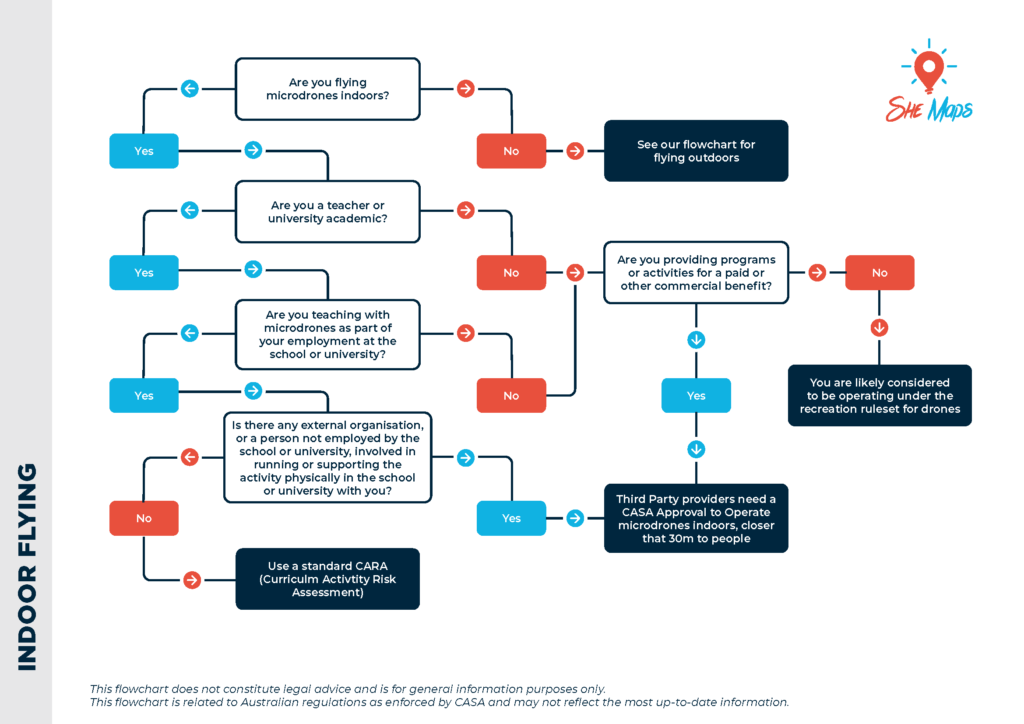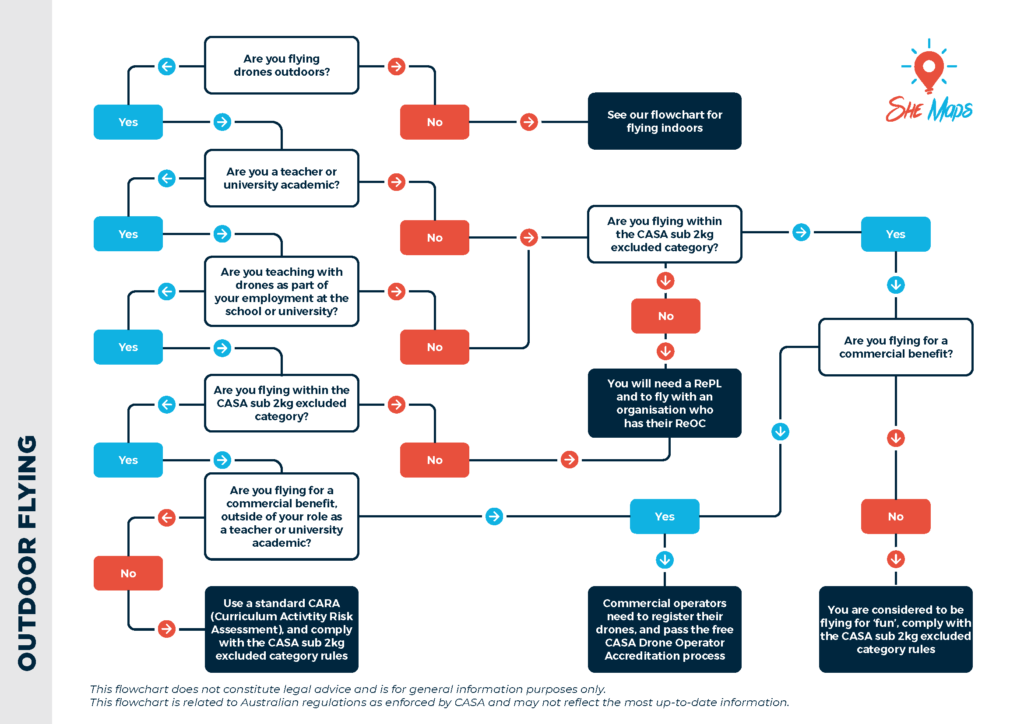CASA have released version 4.0 of "Remotely piloted aircraft systems-licensing and operations"...
Do I need certification to fly drones
Is it worth getting a remote pilot license, or RePL? At She Maps, this is one of the most common asked by teachers, students and recreational flyers.
Our short answer? Most of the time, no!
So let’s break down why most people don’t really need an RePL to get the most out of flying drones.
Why a RePL might not be as important as you think
The RePL course was developed when drones were first coming into the skies. A course was needed to give people the skills to operate safely. So, the course for teaching private pilots to fly planes was used as a framework to create the RePL. The problem is that flying planes and flying drones are quite different skills!
So, what has been created is a course that is, in our view, not fit for purpose for beginners or recreational pilots.
When you are flying drones outdoors, there are some basic rules that you have to comply with. In Australia, these are managed by CASA (Civil Aviation Safety Authority). The vast majority of drones sold in Australia are those that weigh less than 2kg. CASA has a sub 2-kg excluded category which means there are some basic rules you have to follow (see the handy summary video below). If you’re planning to fly within these rules, you don’t need an RePL.
A common misconception is that you need a RePL to fly commercially or to get insurance if you fly commercially. But insurance providers have become a little more understanding of the rules. Some now offer insurance without you having to have a RePL, so long as you are still flying within the excluded category.
If you want to get an exemption to the rules of the excluded category, then you will need a RePL, and if you’re flying under an organisation they to have a ReOC (Remote Operators Certificate). You can then apply for exemptions to these rules. This is a detailed process!
Who Can Teach a RePL Course
A quick online search and you’ll be bombarded with many companies offering training courses for obtaining a RePL. There are a wide range of options offering online, face to face, or mixed delivery courses. They may provide up to seven days’ training, advertised with ‘real drone pilots’ leading the course and varying in price up to several thousand dollars.
But let’s not confuse cost with value.
Like all non-accredited training, there are excellent training providers and then there are the rest. There’s a low barrier to entry for RePL courses, meaning there is a low bar on the educational standards required for instructors (a Cert IV in Training and Assessment is all that is often needed).
Then there is a race to the bottom in terms of course cost. This limits the instructional capability of the person teaching up the front, and the student experience. The training providers who want to invest in quality instructors and a superior student experience are then squeezed out of the market. The training can then become a box-ticking exercise to pass the assessment.
Assessment for assessments' sake
The RePL theory component and style of assessment (which is set by CASA) favours factual rote learning over depth of understanding or the ability to apply knowledge to operational situations. It also disadvantages those with difficulties in reading, writing, and taking tests.
We have worked with people who failed the RePL theory, but have proved to be highly competent in drone operations. As mentioned before, the theory is largely based on the skills required to fly a plane, not a drone. Let’s break the topics down a bit further.
What skills are taught on a RePL course
The RePL consists of 14 hours of theory and 5-6 hours of practical skills for the Remotely Piloted Aircraft System (RPAS) and Aeronautical Radio Operators Course (AROC). The AROC is sometimes offered as an optional add-on to the course and is not a requirement to gain your RePL. This is often a 4-day course, conducted either face to face or a mix of online and face-to-face.
Here are some of the things you’d learn about.
General Aeronautical Knowledge
- Introduction to General Aeronautical Knowledge (multi-rotor, aeroplane, all RPA)
- Aviation Terminology
- Aircraft Components
- Aerodynamics
- Principles of Flight
- Undesired Aircraft States: stalling, spinning, spiral dives, vortex ring state
A comment from one of our staff who did the course was that this component made her feel more confident in being an air traffic controller, with lots of theory on fixed-wing aircraft rather than multirotor drones. There was also a bit of physics behind aerodynamics.
RPA Systems
- Introduction to Remote Aircraft Systems
- Launch & Recovery Systems
- Powertrain Components
- Propulsion Systems
- Electrical System
- Communication & Navigation Systems
- Emergency Procedures
- Lithium Battery Transportation
This section covers a lot of theory on motors, airframes, calculating thrust, antenna systems, determining system faults etc. But again, it mostly focuses of fixed-wing drones and planes. Battery management protocols, their use and calculating the voltage of batteries are also often covered in this component, which can be quite useful.
Air Law & Flight Rules
- Introduction to RPAS Air Law
- ReOC & RePL
- Aviation Legislation
- CASR 101 A & B
- CASR 101 C (Unmanned Aircraft)
- Operations near aerodromes
- CASR 101 F (part 1)
- CASR 101 F (part 2)
- Other Laws
This is important to know if you are flying drones as there are lots of restricted airspaces. But unless you are wanting to fly outside of the rules of the sub 2kg excluded category, AND be flying under a ReOC AND have exemptions from CASA, then you are going to be overwhelmed with the rules.
The legislation can be confusing for most people to understand, which is why there are some basic rules CASA has set up for the majority of people who fly. This is the sub 2kg excluded category.
Operational Planning
- Introduction to Navigation
- Aeronautical Charts
- Visual Terminal Charts
- Airspace
- NOTAMs
- Introduction to NAIPS
- Risk Management
These skills are relevant to aeroplane pilots, or if you are flying for a company with a Remote Operators Certificate (ReOC). Otherwise, you are not going to be able to fly in restricted airspace. If you are not going to fly in restricted airspace, then you are not going to be using any of the skills taught in this topic area.
Basic Meteorology
- Introduction to Meteorology
- Synoptic Charts
- Wind
- Clouds and Precipitation
- Thunderstorms
- Hazardous weather
- Weather Forecasts
This is all interesting information, but drones don’t fly so well in windy conditions, rain, thunderstorms, or higher than clouds. So if you look up and it is rainy or your hat is getting blown off, then it is likely not the weather for flying your drone.
Human Performance
- Introduction to Human Performance
- Memory, Personality, Stress & Fatigue
- Disorientation, vision, alcohol and drugs
- Crew Resource Management and Threat Error Management
- Communication, Situational Awareness, Leadership & Automation
Again, interesting information, but the large majority do not fit into the essential skills for flying drones in a recreation or education setting.
Aeronautical Radio (AROC)
- Introduction to Aeronautical Radio
- VHF Radio Components and Usage
- Standard Phraseology
- Radio Communication
- Controlled Airspace
- Non-Controlled Airspace
- Emergency and Abnormal Operations
As a recreational drone pilot, and even for most flying commercially, you are not going to be flying in restricted airspace. So monitoring the aeronautical frequencies on a personal aeronautical radio is not something you will need to do. For the vast majority of pilots flyind under the exlcued category then, this isn’t an essential skill.
Assessment
For the RePL it is an 85% pass mark for 80 multiple choice questions
Following the completion of the theory lessons for AROC, you will be required to pass a theoretical exam (approximately 24 multiple choice questions, 80% pass mark) and practically demonstrate your ability to communicate using a VHF radio.
Practical Component
The practical component is often flying on an oval, with at least 5-6 hours of flying time, practising different manual flying skills (e.g fly up, in a box, in a diamond etc.). But we have heard from many doing the course that 5-6 hours of effective flying time is not achieved with some training providers. Most of the time this is flying on your own with no co-pilot as well. We encourage beginners to fly with a co-pilot when they are starting as this is a great way to keep an eye out for each other and learn.
We have seen a real lack of teaching in the practical component around proper drone setup, troubleshooting, emergency procedures, how to safely catch a drone (essential for working on boats or areas where the ground is uneven), how to use an app to fly an automated drone mapping mission, how to take photos or videos, and how to manage data. These are the essential skills for flying drones, and when we have worked with people who have done a RePL, they are not confident or competent in a standard to what we deem is acceptable for basic drone operations.
Drone skills that are valuable
The many valuable skills needed in a drone operator are not included in the RePL training. In fact, we would go so far as to say that in general we would rather people have NOT done their RePL training before working with us.
Now that’s a pretty big statement, so let’s justify this position. We have worked with many people who have completed their RePL or Cert III in Aviation (Remote Pilot) who unfortunately graduate from these courses with either a lack of confidence in how to actually fly, or have an inflated and unrealistic perception of their own ability. Most of the time we find they have not been trained in the aspects of drone operation that are actually valuable as mentioned above. So it’s actually easier for us to start with ‘blank slate’ people.
The irrelevant content in the RePL curriculum for recreational and educational drone users is a distraction from the learning process. It can take the emphasis away from the truly useful components for entry-level drone pilots. Here is what we believe should be the focus for those beginning their outdoor drone flying experience.
- Safety of yourself, the drone, others, and property
- Planning and operating according to the regulations
- Competence and confidence in flight skills
- Excellent communication skills between pilot and co-pilot
- Ability to plan and execute a mapping mission
- Ability to capture analysis-ready data (including photos, videos)
- Safely landing and catching a drone
- Looking after equipment and data
When should I do my RePL?
The RePL is a course that is required for people who want to work in the industry and fly drones outside the excluded category. So, if you want to fly drones over 2kg in weight, in restricted airspace, at night, or in other restricted operating conditions than you need an RePL.
The RePL is a CASA requirement to demonstrate that pilots have met certain standards according to the regulator, rather than industry. But to be able to fly drones outside of the excluded category, then the pilot also needs to be flying under the direction of an organisation that holds a Remote Operators Certificate (ReOC). This is an additional certification requirement administered by CASA.
The true benefits of holding a RePL are only recognised when working in industry, for an organisation that holds a ReOC.
If I don’t do my RePL, then what should I do instead?
For schools wanting to give their students an introduction to the drone industry, or teachers wanting more confidence in flying sub 2kg drones, who have completed our microdrone course (our recommended starting course for all beginner drone pilots), here are our recommendations:
- Learn the rules from CASA for the sub 2kg excluded category
- If you are over 16 years of age, complete the CASA drone operator accreditation (a free test of your drone safety knowledge)
- Understand the equipment, learn from others, practice small flights and build your confidence.
If you feel overwhelmed and nervous about flying, then we recommend taking a one or two-day face-to-face introduction course that will give you all the foundational information you need and help get you flying.
Then practice! Practice flying with the knowledge that you are able to comply with the legislation, and that you understand the equipment.
If teachers then want their students to have an industry level certification for drones before leaving school, then a RePL is definitely an option. But in our opinion, it is not a good starting point for teachers and students learning to use drones outdoors.
We would also love to see you try out some mapping with your drone and contribute data to our sister company’s (GeoNadir) vision to create the most detailed map of the planet, to protect at-risk ecosystems.
Flowcharts to get started
To help you navigate the CASA rules, we have developed two flow charts. One for those flying microdrones indoors, and the other for flying sub 2kg drones outdoors. Access them below.
If you enjoyed this article, then you might want to read our Ultimate Guide to Buying Drones
Need more information on drones for schools? We recommend that you check out the following articles:
About She Maps.
She Maps is Australia’s leading expert in drone and geospatial education.
She Maps assist schools with the purchasing of drones, school-industry created drone and geospatial teaching resources and highly supportive teacher professional development.
- FREE eBook – How to start a drone program at your school – Teachers Guide – Download Now
- Find out more about our programs
- Take our programs for a spin – purchase a program
- Become a She Maps Member for just $240/year – More information
- Learning Solutions Guide – Programs, Products and Pricing Guide – Read now
Ready to buy drones for your school? We are an authorised DJI reseller in Australia






